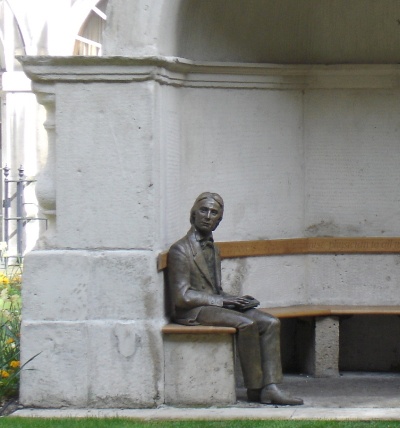John Keats, selected poems Contents
Life’s brevity versus art’s permanence
The reality of death
 Keats had to confront death at a very early age. His father died when he was eight and his mother when he was fifteen. Keats’ training at Guy’s Hospital would have confronted him with the extremities of human suffering, of which he had further experience when he nursed his beloved brother Tom, who died of tuberculosis when Keats was twenty-three.
Keats had to confront death at a very early age. His father died when he was eight and his mother when he was fifteen. Keats’ training at Guy’s Hospital would have confronted him with the extremities of human suffering, of which he had further experience when he nursed his beloved brother Tom, who died of tuberculosis when Keats was twenty-three.
To My Brothers
In his sonnet To My Brothers Keats reflects on the fragility of human happiness. The scene he describes has so much warmth: that of fraternal love and the warmth of the fire. However, the final line shows an acute awareness that what the brothers now enjoy will not last forever. The ‘great voice’ (i.e. God’s) could summon their spirits at any time. In his letters Keats stated:
On Seeing the Elgin Marbles
In On Seeing the Elgin Marbles Keats reflects on the pleasures and the pains of human creativity. The Marbles represent the best of human imagination. They are ‘glories of the brain’ yet they are subject to time, displacement, decay. As in so much of his poetry, Keats is fascinated and disturbed by the fact that art can have such sharply contrasting effects: the beauty inspires and moves but it also reminds him that everything is subject to change – and that art will remain long after his death.
When I have fears that I may cease to be
In When I have fears that I may cease to be Keats struggles with the prospect of dying before he has achieved artistic success. He has so much he wants to write and possibly little time to put his thoughts on paper. The speaker is extremely sensitive to beauty, whether manifested in the stars or in a woman seen by chance. The thought that he may die young and never be able to experience again either beauty or love makes him feel desolate, contemplating ‘nothingness’, the certainty of annihilation and with it the elimination of his fears.
Ode to Melancholy
In the Ode to Melancholy Keats reflects that in this world all things are transitory; nothing lasts forever. Keats finds the presence of eternal beauty the source of the deepest melancholy, since it emphasises just how fleeting human existence is. The most beautiful things provoke melancholy thoughts because they hint at the everlasting principle of beauty but are themselves bound to fade, since they derive from an ephemeral world.
Keats realises that it is when a man most deeply loves the beautiful, when he most exploits his capacity for joy, that he is most fully aware of the bitter contrast between the real and the ideal. Indeed full consciousness of this contrast is deeply painful. Imagination and sensitivity, qualities which all true artists must have in abundance, lead to suffering. If he loved beauty less, he would care less that he could not hold on to it for long.
Ode to a Nightingale
Similar themes are addressed in Ode to a Nightingale, in which the poem’s speaker wishes (though perhaps only for dramatic effect) to die while listening to the songbird of the title. On the one hand, the nightingale’s song is seen as offering relief from the day-to-day pains of living – ‘the weariness, the fever and the fret’ of the human condition, of the world where ‘men sit and hear each other groan’ and where ‘youth grows pale, and spectre-thin, and dies’. On the other hand, the ‘immortality’ of the bird and the eternal nature of its song makes Keats painfully aware of human transience and the fragility of his own life.
So art can transcend human transitoriness: it can outlive its creator and continue to move and inspire people into the distant future. However, its relative permanence is also a reminder of mortality and the brevity of human life.
Ode on a Grecian Urn
In Ode on a Grecian Urn Keats explores difference in viewpoint between the ephemeral people depicted on the urn and that of the viewer. In stanza 4 the mysteriously moving group fails to see the pathos of its own situation. No one in this group seems remotely aware that, for the group to exist, the town from which they have come has had to be emptied: the procession is beautiful but the town left behind is desolate. In fact the procession will always remain beautiful, even though the culture which produced it has long vanished.
A Keatsian paradox
A painful awareness of the brevity of life is inextricably linked, in Keats’ poems, to a heightened sense of beauty and joy. Just as we rarely appreciate things so much as when we lose them, so transitory human life becomes more valued the more one is aware of its fragility and brevity. For Keats, poetry can be neither beautiful nor useful if the poet shuts his eyes to the dark reality of human suffering and death.
Recently Viewed
Scan and go
Scan on your mobile for direct link.